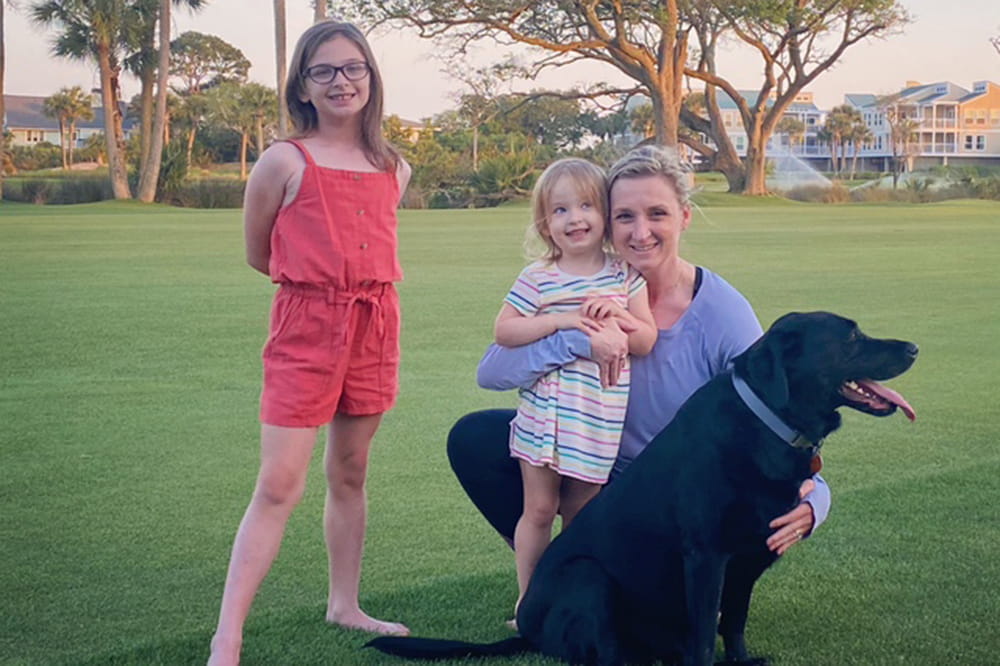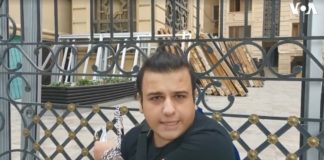Kelly Lewis never would have thought to get a mammogram on her own. There’s no history of breast cancer in her family; she had some protective factors, like nursing both of her children, and – quite honestly – she didn’t even realize that doctors start to recommend mammograms once you hit 40.
So she’s forever grateful that her OB-GYN, David Soper, M.D., reminded her to get one. She visited him for a check-up in early 2022 after his office called to alert her that, like many others whose schedules were disrupted because of COVID, she hadn’t seen him since her six-week postpartum visit in 2019.
“It was sort of a joke, you know, like, ‘You’re 40: Congratulations, you can go get a mammogram now,’” she said.
First-time mammograms often necessitate a callback because there’s nothing to compare them to, she was told, so she wasn’t too worried when she was asked to do additional imaging. But after the second mammogram, the radiologist told her they had found suspicious calcifications; she would need a biopsy.
“That was just mind-boggling to me because the only way I had understood breast cancer was that you feel a lump,” Lewis said. “That you could go into some routine screening, and then this thing’s been in your body when you have no reason to think that it was there – it’s really shocking.”
The biopsy confirmed that it was cancer. Cancer is never good news, but the next best thing for Lewis was that the cancer was caught early. She was diagnosed with stage 0 noninvasive ductal carcinoma in situ. A multidisciplinary team at MUSC Hollings Cancer Center immediately swung into action to develop a plan of treatment in consultation with Lewis.
With two little girls at home, Lewis worried whether she might have a genetic mutation associated with breast cancer that she could have passed to her daughters. She met with Kevin Hughes, M.D., the director of the MUSC Hollings Hereditary Cancer Clinic, who specializes in helping people to sort out the best course of action given their individual health histories, genetics and risk tolerance. Happily, genetic testing showed that she didn’t have one of the known genetic mutations associated with breast cancer.
Lewis’s treatment course would include a lumpectomy and radiation treatment. She’ll follow that with five years of taking the drug tamoxifen to reduce the risk of recurrence.
She’s at a point now in her treatment where she feels like she’ll be OK. Early on, though, Lewis was awash in conflicting emotions. She was scared, yet she felt guilty about being scared because her prognosis was excellent, thanks to the cancer being caught so early. Everyone assured her that she would be OK. But it was hard to really, truly believe that.
Enter Caroline Gay Martin.
Martin is a mammography tech at Hollings with 25 years of experience in the world of radiology. She’s also a breast cancer survivor. Just like Lewis, she was diagnosed with ductal carcinoma in situ after an abnormal finding on a mammogram. In her case, the mammogram picked up a radial scar – a type of lesion that’s usually benign. Only after surgery to remove the tissue and subsequent testing did Martin learn that it had actually been cancer.
When Lewis came in for Magseed placement – a magnetic seed that’s implanted at the site of the cancer to guide surgeons to the precise location of the tumor during surgery – she still felt worried and scared.
“I don’t know if she could just read my face that day – I’m sure I looked stressed out,” Lewis said. “Everyone had said I was going to be fine. But Gay said to me, ‘I’ve had this, and I’m here. I had DCIS and truly I can tell you, this is the best place. You’re going to be fine.’ And that – for the first time, I really did feel like, talking to Gay, that I was going to be fine.”
“Just because you feel good and you don’t feel a lump, and you don’t have family history, that’s not a reason not to get a mammogram. It’s uncomfortable. I totally agree. I don’t like them myself – but they’re so important.”
Caroline Gay Martin
mammography technologist
Martin said she uses her experience to connect with patients.
“I think once you’re on that side, when you see somebody who you can tell just by their mannerisms that they’re really struggling with what’s going on, I can honestly look at them and say, ‘Hey, I know what you’re going through. I know the questions that are running through your mind. I know the worries that you have. I’ve been there,’” she said. “And I think it helps because they realize, ‘Hey, I’m not the only one. This person really understands.’ And I think it makes a better connection with your patient when you can do that for them.”
Lewis said that after her experience, she’s going to be “that friend” who reminds everyone to get an annual mammogram. So many of her friends are busy moms who just haven’t thought about it, she said. Had she waited four or five years, she said, who knows at what stage the cancer would have been by the time it was found or what her prognosis would have been.
“These screenings really do catch things before they become serious, before you have to have extensive treatment,” she said.
Martin agreed.
“Just because you feel good and you don’t feel a lump, and you don’t have family history, that’s not a reason not to get a mammogram,” she said. “It’s uncomfortable. I totally agree. I don’t like them myself – but they’re so important.”







